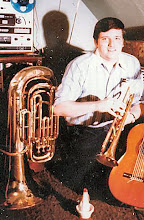

1965 Coral CRL 757475 Stereo / CRL 57475 Mono
Side One
1. Ja-Da
2. Quiet Nights
3. Muskrat Ramble
4. Debbie
5. Red Roses For A Blue Lady
6. Do You Know What It Means To Miss New Orleans
Side Two
1. Love For Sale
2. Panama
3. Willow Weep For Me
4. Momma Was There
5. Josephine
6. Tin Roof Blues
Liner Notes:
Vibraphone Solos With Instrumental Accompaniment
The instrument used on this Album is the "Musser Century Vibe" used exclusively by Godfrey Hirsch.
Personnel:
Godfrey Hirsch - Vibes
Pete Fountain - Clarinet
Eddie Miller - Tenor Saxophone
Earl Vuiovitch - Piano
Paul Guma - Guitar
Oliver "Stick" Felix - Bass
Paul Edwards - Drums
Nick Fatool - Drums
You know Godfrey Hirsch if you've ever seen Pete Fountain's group in action. He plays vibes, and his choreography for mallets is certainly something to behold. A great showman, he also makes an invaluable contribution to the ensemble in terms of color, and when the rhythm needs extra punch he shifts over to the second percussion chair to beat a snare drum.
As Pete's right-hand man, Godfrey works and lives a great deal of the time in Pete's Place, New Orleans. In-deed, when the boss is away on missions of importance, it is Godfrey who usually takes over in his place. That's right. He takes Pete's place in Pete's Place. Pardon the emphasis.
Most of the performances on this record were made during Mardi Gras in 1964 and 1965, when Pete Fountain was out on the streets, not roistering or behaving in any unseemly fashion, but marching his music like a well-brought-up son of the Crescent City.
There were some musician guests down there for the festivities, and after a while they hied their weary feet to Pete's place of refreshment. You may have heard drummer Nick Fatool enjoying himself in 1964 on the earlier album, Pete's Place (CRL 57453), but this time there is another visitor, Eddie Miller. Not that Eddie is any newcomer to New Orleans, because he was born there. Normally, he is active on the West Coast, where he participates in many of those sessions which help to keep his hometown's jazz idiom alive, but here his tenor saxophone is heard instead of Pete's clarinet on three tracks.
Thus it is Pete's group, without Pete, but with guests, and headed by Godfrey Hirsch, that is ready to entertain you in this set. Many of the numbers are those used to introduce shows at the club before the clarinetist mounts the stand, and they roll with ease and fluidity in familiar routines, Eddie Miller fitting right in as though he were one of the regulars.
Ja-Da, the opener, is one of those good of good ones. In fact, it has been quietly rocking the nation ever since 1918, the year when New Orleans jazz really got going on its travels around the world. The vibes and Oliver Felix's bass move it out, the mood relaxed and the tempo medium, Nick Fatool kicking it along with accurate accentuations. Enter Eddie Miller, very much at ease and swinging freely. There follow exchanges between bass and drums, between vibes and tenor, and then the out chorus. The performance makes a good introduction to an album that is smoothly professional and never exhibitionistic. Because the men know where they're going on the well-organized charts, there is no fuss and no wasted effort.
The program agreeably contrasts old standards from the New Orleans repertoire, such as Muskrat Ramble, Panama and Tin Roof Blues, with others of more recent vintage like Red Roses For A Blue Lady and Do You Know What It Means To Miss New Orleans. There is also a bow in the direction of Brazil and Antonio Carlos Jobim with Quiet Nights, where the Hirsch versatility is demonstrated in dark colors appropriate to a nocturnal mood. On this, on the pretty Debbie, and on Momma Was There, which provide changes of pace, he plays with a restraint and delicacy that recall Red Norvo's in similar contexts. On the more insistently danceable tempos, he swings with an insidious but well-defined beat. The effective tempo changes on Willow Weep for Me show off his rhythmic control very handsomely, and this interpretation, especially, reveals the close understanding that exists within Pete Fountain's quintet. Its tonal quality is excellent and it moves as one over Paul Edwards' tasteful brushwork. There are passages elsewhere, too, where each of its members shines individually, Panama giving first guitarist Paul Guma and then pianist Earl Vuiovitch a sixteen-bar opportunity to take off.
All too soon, Eddie Miller is sounding the sad, forlorn strains of Tin Roof Blues, and it is time to leave Pete's Place, but it is some consolation to know that it is left in the very able hands of Godfrey Hirsch.
- STANLEY DANCE



No comments:
Post a Comment